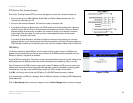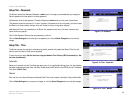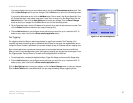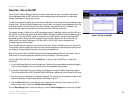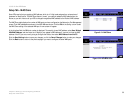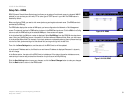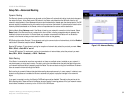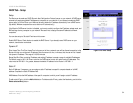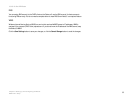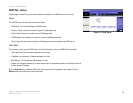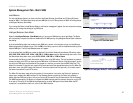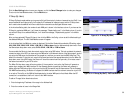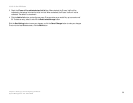
32
Chapter 6: Setting up and Configuring the Router
Setup Tab - Advanced Routing
10/100 16-Port VPN Router
Setup Tab - Advanced Routing
Dynamic Routing
The Router's dynamic routing feature can be used, so the Router will automatically adjust to physical changes in
the network's layout. Using the dynamic RIP protocol, the Router calculates the most efficient route for the
network’s data packets to travel between the source and the destination, based upon the shortest paths. The RIP
protocol regularly broadcasts routing information to other routers on the network. It determines the route that the
network packets take based on the fewest number of hops between the source and the destination.
Working Mode. Select Gateway mode if the Router is hosting your network’s connection to the Internet. Select
Router mode if the Router exists on a network with other routers, including a separate network gateway that
handles the Internet connection. In Router Mode, any computer connected to the Router will not be able to
connect to the Internet unless you have another router function as the gateway.
RIP (Routing Information Protocol). To use dynamic routing for communication of network data, click the Enabled
radio button. Otherwise, keep the default, Disabled.
Receive RIP versions. To use dynamic routing for reception of network data, select the protocol you want: None,
RIPv1, RIPv2, or Both RIP v1 and v2.
Transmit RIP versions. To use dynamic routing for transmission of network data, select the protocol you want:
None, RIPv1, RIPv2 - Broadcast, or RIPv2 - Multicast.
Static Routing
If the Router is connected to more than one network or there are multiple routers installed on your network, it
may be necessary to set up static routes. The static routing function determines the path that data follows over
your network before and after it passes through the Router. You can use static routing to allow different IP domain
users to access the Internet through the Router.
Static routing is a powerful feature that should be used by advanced users only. In many cases, it is better to use
dynamic routing because it enables the Router to automatically adjust to physical changes in the network's
layout.
If you want to use static routing, the Router's DHCP settings must be disabled. Then add routing entries to the
Static Routing table. These entries tell the Router where to send all incoming packets. All of your network routers
should direct the default route entry to the 10/100 16-Port VPN Router.
Figure 6-25: Advanced Routing



